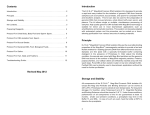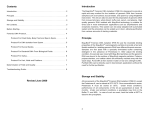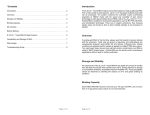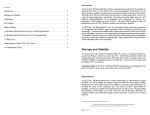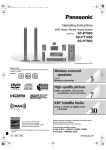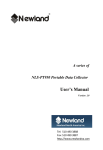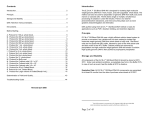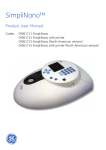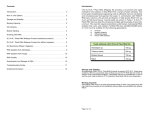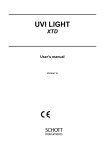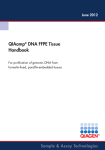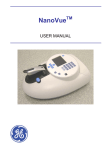Download Manual - Omega Bio-Tek
Transcript
Contents Introduction Introduction. . . . . . . . . . . . . . . . . . . . . . . . . . . . . . . . . . . . . 2 Overview. . . . . . . . . . . . . . . . . . . . . . . . . . . . . . . . . . . . . . . 2 Storage and Stability.. . . . . . . . . . . . . . . . . . . . . . . . . . . . . . 2 Kit Contents. . . . . . . . . . . . . . . . . . . . . . . . . . . . . . . . . . . . . 3 Before Starting. . . . . . . . . . . . . . . . . . . . . . . . . . . . . . . . . . . 3 E.Z.N.A.™ E.Z.N.A.™ Bacterial RNA Kit allows rapid and reliable isolation of high-quality total cellular RNA from a wide variety of bacterial species. Up to 1 x 10 9 Bacterial cells can be processed. The system combines the reversible nucleic acid-binding properties of Omega Bio-Tek’s HiBind® matrix with the speed and versatility of the spin column technology to yield approximately 50 -100 ìg of RNA. There are no organic extractions, thus reducing plastic waste and hands-on time to allow multiple samples to be processed in parallel. Purified RNA has Abs260/Abs280 ratios of 1.8-2.0 and is suitable for the following applications: Bacterial RNA Spin Protocol. . . . . . . . . . . . . . . . . 4 ! ! ! ! Vacuum/Spin protocol. . . . . . . . . . . . . . . . . . . . . . . . . . . . . . 6 Quantification and Storage of RNA. . . . . . . . . . . . . . . . . . . . . 7 RT-PCR Northern Analysis Differential display Poly A+ RNA selection RNA Quality. . . . . . . . . . . . . . . . . . . . . . . . . . . . . . . . . . . . . 7 Troubleshooting Guide.. . . . . . . . . . . . . . . . . . . . . . . . . . . . . 8 Revised June 2008 Overview If using the E.Z.N.A.™ Bacterial RNA Kit for the first time, please read this booklet to become familiar with the procedures. Bacterial cells are grown to log-phase and harvested. Bacterial cell walls are removed by lysozyme digestion. Following lysis, binding conditions are adjusted and the samples are applied to HiBind® RNA spin-columns. Two rapid wash steps remove trace salt and protein contaminants, and RNA is eluted in water or low ionic strength buffer. Purified RNA can be directly used in downstream applications without the need for further purification. Storage and Stability All components of the E.Z.N.A.™ Bacterial RNA Kit are stable for at least 24 months from the date of purchase when stored at 22oC-25oC. During shipment or storage in cool ambient conditions, precipitates may form in Buffer BRK. It is possible to dissolve such deposits by warming the solution at 37oC. New This Edition A heat incubation step has been added to reduce the amount of copurification of DNA. Page 2 of 10 Kit Contents Bacterial RNA Spin Protocol Product Number R6950-00 R6950-01 R6950-02 5 Preps 50 Preps 200 Preps 5 50 200 ! Tabletop microcentrifuge and RNase free 2.0 or 1.5 ml tubes. 15 150 600 ! Absolute ethanol (96%-100%) - do not use other alcohols. BRK Lysis Buffer 2 ml 20 ml 80 ml ! Waterbath or Incubator set to 70EC RNA Wash Buffer I 5 ml 50 ml 200 ml RNA Wash Buffer II 5 ml 12 ml 50 ml 200 mg 2.0 g 8.0 g 8 mg 80 mg 4 x 80 mg DEPC Water 1.5 ml 10 ml 40 ml User Manual 1 1 1 Purification ® HiBind RNA Mini column 2 ml Collection Tubes Glass Beads Lysozyme Materials supplied by users This method allows bacterial RNA isolation from up to 3 ml LB culture. 1. Grow Bacteria in LB media to log phase. (Do not use overnight culture.) 2. Harvest no more than 3 ml culture (< 5 x 108 bacteria) by centrifugation at 4,000-5000 x g for 5-10 min at 4EC. 3. * B uffe r B R K contain s a ch aotropic salt. Use glove s an d prote ctive e ye w are w h e n han dlin g w ith th is solu tion . Discard medium and resuspend cells in 100ìl Lysozyme/TE Buffer. Mix by vortexing at maxi speed for 30 seconds. Before Starting Please take a few minutes to read this booklet thoroughly to become familiar with the protocol. Prepare all materials required before starting procedure to minimize RNA degradation Note: The amount of enzyme required and/or the incubation time ! some bacteria, other enzymes may be more effective. Prepare a stock solution of lysozyme (provided) at 15 mg/ml with TE buffer and aliquot into adequate portions. Store aliquots at -20oC. ! Bacterial should be harvested in log-phase growth. ! â-mercaptoethanol (â-ME) must be added to Buffer BRK before use. This mixture can be stored for 1 month at room temperature. may need to be modified depending on the bacterial strain used. Complete digestion of the cell wall is essential for efficient lysis. For 4. Incubate at 30EC for 10 minutes. Incubate on a shakerincubator or vortex for 20 seconds for every 2 minutes during incubation. ! 5. Add 350 ìl BRK lysis buffer and 25-40 mg glass beads to the sample and vortex vigorously for 5 minutes. Dilute RNA Wash Buffer II Concentrate with ethanol as follows and store at room temperature. Centrifuge for 5 minutes at maximum speed in a micro-centrifuge. R6950-00 Add 20 ml absolute ethanol (96%-100%) Note: Ensure â-mercaptoethanol (â-ME) is added to BRK R6950-01 Add 48 ml absolute ethanol (96%-100%) Lysis Buffer (20 ìl/ml) before use. R6950-02 Add 200 ml absolute ethanol (96%-100%) per bottle 6. Transfer 400ìl of the supernatant into a new 1.5 ml centrifuge tube. Page 4 of 10 Note: 7. Incubate sample at 70EC for 5 minutes. Centrifuge at • DNase I is very sensitive and is subject to physical maximum speed (>13,000 x g) for 2 minutes. Transfer the denaturation; so do not vortex the DNase I mixture. Mix supernatant into a new 1.5 ml tube (not supplied) gently by inverting the tube. Prepare the fresh DNase I digestion mixture before RNA isolation. 8. Add 280 ìl absolute ethanol (96-100%) to the lysate and mix well • OBI DNase I digestion buffer is supplied with OBI RNasefree DNase I set. by vortexing at maxi speed for 15 seconds. • Standard DNase buffers are not compatible with on9. Apply sample, including any precipitate that may have formed, to ® a HiBind membrane DNase I digestion. RNA mini column inserted in a 2 ml collection tube. Centrifuge for 30 seconds at 8,000-10,000 x g. Reuse the b. Dry column by spinning an additional 30 seconds, then pipette 75 ìl of the collection tube for next step. DNase I digestion reaction mix directly onto the surface of the HiBind® RNA membrane in each column. Make sure 10. Add 400ìl RNA Wash Buffer I to the column. Centrifuge at 10,000 to pipette the DNase I digestion mixture directly onto the x g for 2 minutes. Discard the flow-through and collection tube. If membrane. DNase I digestion will not be complete if some of the on-membrane DNase I digestion is desired, proceed to Step 11, mix sticks to the wall or the O-ring of the HiBind® RNA column. otherwise go to Step 13. c. Incubate at room temperature(25-30NC) for 15 minutes. 11. DNase I Digestion (Optional) Since HiBind® RNA resin and spin-column technology actually 11. Place HiBind® RNA Mini column in a clean 2 ml collection tube, and removes most of DNA without the DNase I treatment, it is not add 500 ìl RNA Wash Buffer I. (If on-membrane DNase I necessary to do DNase digestion for most downstream applications. digestion was performed in the previous step, allow wash However, certain sensitive RNA applications might require further buffer to soak column at least 5 minutes before proceeding). DNA removal. Follow the steps below for on-membrane DNase I Centrifuge as above and discard flow-through. digestion. (See DNase I manual, Product No. E1091 for detailed 12. Place HiBind® RNA Mini-column in a new 2 ml collection tube information.) (provided). Add 500 ìl RNA Wash Buffer II and spin for 30 ® a. For each HiBind RNA column, prepare the DNase I digestion seconds at 10,000 x g. Discard flow-through and reuse the collection tube. reaction mix as follows: OBI DNase I Digestion Buffer 73.5 ìl RNase-free DNase I (20 Kunitz 1.5 ìl 13. Add 500 ìl RNA Wash Buffer II to column and centrifuge for 30 seconds at 8,000-10,000 x g to wash again. Discard the flow-through and reuse the collection tube. unites/ìl) Total volume 75 ìl 14. Using the same collection tube, dry the column by spinning for 2 minutes at 8000-10,000 x g. Page 6 of 10 Note: Drying the HiBind® RNA Mini column is very important for removal of residual ethanol that will otherwise interfere with downstream applications. 15. Transfer HiBind® RNA Mini column to a new RNase free 1. 5 ml collection tube (not supplied) and add 50-100 ìl DEPC water directly onto the HiBind® membrane. Centrifuge for 1 minute at 8,000-10,000 x g to elute. Repeat if the expected RNA yield is more than 60 ìg. 8. Place the column in a clean 1.5 ml micro centrifuge tube and add 50-100ìl DEPC water. Stand for 1-2 minute and centrifuge for 1 minute to elute RNA. Quantification and Storage of RNA centrifugation, follow steps blow. To determine the concentration and purity of RNA, measure absorbency at 260 nm and 280 nm in a spectrophotometer. 1 O.D. unit measured at 260 nm corresponds to 40 ìg of RNA per ml. The ratio of A260/A280 of pure nucleic acids is 2.0, while for pure protein it is approximately 0.6. A ratio of 1.8-2.0 corresponds to 90%-100% pure nucleic acid. (Phenol has an absorbency maximum at 275 nm and can interfere with spectrophotometric analysis of DNA or RNA. However, the E.Z.N.A.™ Bacterial RNA Kit eliminates the use of phenol and avoids this problem.) Store RNA samples at -70o C in water. Under such conditions RNA prepared with the E.Z.N.A.™ system is stable for more than a year. Note: RNA Quality Vacuum/Spin Protocol (V-Spin Column Only) Carry out lysis, homogenization, and loading onto HiBind® RNA column as indicated in previous protocol (Steps 1-8). Instead of continuing with Please read through previous section of this manual before using this protocol. 1. Prepare the vacuum manifold according to manufacturer’s instructions and connect the HiBind® RNA V-Spin column to the manifold. 2. Load the homogenized sample into HiBind® RNA V-spin column. 3. Switch on vacuum source to draw the sample through the column. 4. (Optional): Perform on-membrane DNase I digestion steps if sensitive downstream application is desired. (See Step 10, Pages 5-6, above) 5. Wash the column by adding 500 ìl RNA Wash Buffer I. Draw the wash buffer through the column by turning on the vacuum source. 6. Wash the column by adding 500 ìl RNA Wash Buffer II. Draw the wash buffer through the column by turning on the vacuum source. 7. Insert the column into a 2 ml collection tube and transfer the column to a micro centrifuge. Spin for 1 minute to dry the column. It is highly recommended that RNA quality be determined prior to all analyses. The quality of RNA can be assessed by denaturing agarose gel electrophoresis and ethidium bromide staining. Several sharp bands should appear on the gel. These are the 28S and 18S ribosomal RNA bands as well as certain populations of mRNA and possibly viral RNA bands. If these bands smear towards lower molecular weight RNAs, then the RNA has undergone major degradation during preparation, handling, or storage. RNA molecules less than 200 bases in length do not efficiently bind the HiBind® matrix. Page 8 of 10 Troubleshooting Guide Low Abs ratios Problem Cause Suggestion Little or no RNA eluted RNA remains on the column ! ! ! Clogged column Degraded RNA Column is overloaded ! Reduce amount of starting material. Bacterial cell wall is not completely removed ! Use longer incubation time for lysozyme digestion or add more lysozyme. Incomplete disruption or lysis of bacterial. ! Use longer incubation time for lysozyme. Increase centrifugation time. Reduce amount of starting material Source ! ! ! RNase contamination ! ! Problem in downstream applications Salt carry-over during elution ! ! ! DNA contamination Repeat elution. Pre-heat DEPC-water to 70o C prior to elution. Incubate column at RT for 10 min with DEPC water prior to centrifugation. Co-purification of DNA ! Follow protocol closely, and work quickly. Make sure that 2mercaptoethanol is added to BRK Lysis Buffer Ensure not to introduce RNase during the procedure. Check buffers for RNase contamination. Ensure Wash Buffer II has been diluted with 96%100% ethanol as indicated on bottle. Diluted Wash Buffer II must be stored at room temperature. Repeat wash with Wash Buffer II. Digest with RNase-free DNase I and inactivate at 75o C for 5 min. Page 10 of 10 RNA diluted in acidic buffer or water ! DEPC-treated water is acidic and can dramatically lower Abs260 values. Use TE buffer (pH 8) to dilute RNA prior to analysis.





